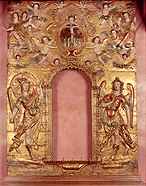
Search
Info Updates
National Threat Advisory
Elevated
![]()
Significant Risk of Terrorist Attacks
Report Suspicious Activity:
1-866-DHS-2-ICE1-866-347-2423
Information for families of ICE detainees:
Contact InformationFact Sheets
July 26, 2005
Fact Sheet
El Altar de Challapampa
(The Challapampa Altar)
 A retablo (from retro [behind] + tabula [table or panel]) is the structure or screen that sits behind and above the altar in a church, often fitted with niches for statues or religious objects. This particular retablo is comprised of several carved, wooden panels covered in gold leaf and pigments, depicting the archangels Michael and Gabriel flanking the open central niche, and a host of cherubs floating above, around a cartouche containing a crucifix, under the Jesuit anagram ‘IHS’. When assembled, the screen measures about 9 by 11 feet, and weighs nearly 900 pounds.
A retablo (from retro [behind] + tabula [table or panel]) is the structure or screen that sits behind and above the altar in a church, often fitted with niches for statues or religious objects. This particular retablo is comprised of several carved, wooden panels covered in gold leaf and pigments, depicting the archangels Michael and Gabriel flanking the open central niche, and a host of cherubs floating above, around a cartouche containing a crucifix, under the Jesuit anagram ‘IHS’. When assembled, the screen measures about 9 by 11 feet, and weighs nearly 900 pounds.
Country of Origin: Peru
Date: Created between 1575 and 1591 A.D.
Attribution: Fr. Aloisio Bernardo Joan Democrito Bitti [Bernardo Bitti], and Pedro de Vargas.
Laws Violated: Cultural Property Implementation Act
About the Artists:
An Italian Jesuit missionary trained in Rome and Spain, Bernardo Bitti was one of the most influential artists to work in 16th and 17th century South America, particularly in Peru. Scholars believe that Bitti collaborated as painter and gilder with the sculptor Pedro de Vargas on the creation of this extraordinary piece.
Sequence of Events:
In January 2002, “El Retablo de Challapampa” was stolen from a community center in Challapampa, Peru, where it was being held while its home, the Church of San Pedro, underwent repairs.
In May 2003, the ICE New York investigation revealed that the piece was being sold at Ron Messick Fine Arts, a gallery in Santa Fe, New Mexico, so ICE Special Agents and the U.S. Attorney’s Office in the Southern District of New York executed federal search warrants and subpoenas in New Mexico and other locations to recover the artifact. This investigation received assistance from the ICE field offices in Albuquerque, Tucson, El Paso, Oxnard, San Francisco, and the Mexico City attaché office; the Washington Bureau of Interpol; and U S Customs and Border Protection.
Following the convening of a Federal Grand Jury, criminal prosecution of Ron Messick, owner of the gallery, was initiated by the US Attorney’s Office in New York. Those proceedings were abated due to his poor health; he subsequently died. Executors of Messick’s estate voluntarily surrendered the piece to ICE; U.S. Customs and Border Protection assisted with the legal forfeiture, and have held the altarpiece in secure storage throughout this investigation. It is currently in El Paso, Texas, where it will be released to Peruvian authorities in a simultaneous ceremony today.






